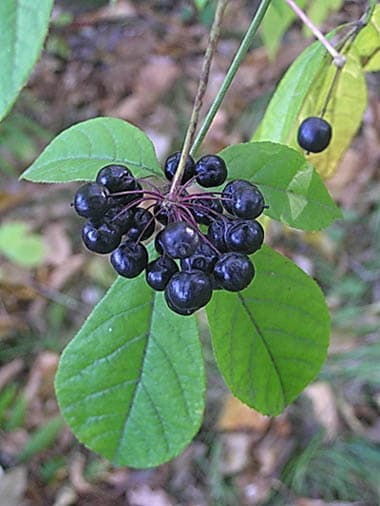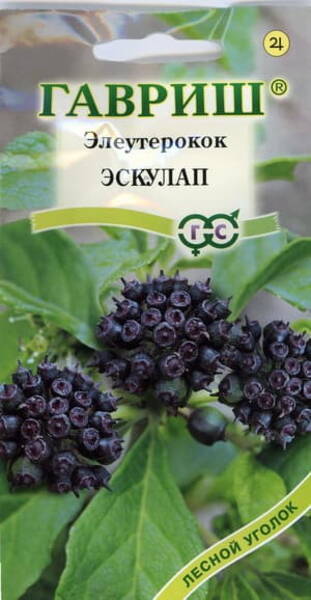Ex Tax: 2.15€
A winter-hardy, low-branched shrub 2-2.5 m (up to 4-5 m) high. Young shoots are yellow, densely covered with thin thorns, slightly directed downwards, old ones are light gray with fewer thorns. The leaves are long-petiolate, compound, five-fingered (dark green and smooth on top, and lighter below).
The flowers are small, with pale purple or yellow petals, collected at the tops of the branches in spherical umbrellas on long peduncles. The fruits are black, berry-like drupes, spherical or slightly oblong in shape, up to 1 cm in diameter, with a pleasant light aroma.
Eleutherococcus blooms in July-August, the fruits ripen in September-October. The plant is shade-tolerant, prefers fertile, well-moistened soils.
Before sowing, the seeds are kept at room temperature for 2-3 months, gradually reducing it to +5°C, then 1.5-2 months at 0+3°C.
Treating seeds with growth regulators before stratification increases germination. When sowing seeds in the spring, shoots appear only in the 2nd year. Young plants develop slowly and bloom in the 4-5th year.
Eleutherococcus is interesting in single and group plantings, landscape parks, as living untrimmed hedges.
Used in medicine: preparations from the leaves, berries and rhizomes of Eleutherococcus increase the body's performance and endurance, improve well-being.

Eleutherococcus preparations are no worse than the famous ginseng, and according to some tests even surpass it. It is completely harmless, non-toxic, it can be used for as long as you like, while ginseng is used only periodically. It is no coincidence that eleutherococcus is highly valued by astronauts and, when going on their near-earth expeditions, they always take eleutherococcus extract with them. Eleutherococcus preparations, like ginseng, increase physical and mental performance, have a general strengthening, anabolic, wound-healing, hypotensive and antidiabetic effect, delay the elimination of vitamin C from the body, involve fats in metabolism, reduce cholesterol levels in the blood, and have many other positive properties.
Eleutherococcus fruits are an excellent food product. They are used to make jam and candied, using 1-1.5 kg of sugar per 1 kg of fruit. Fresh berries are used as a seasoning for hot and cold meat, fish and vegetable dishes, as well as spices for pickling and marinating vegetables and fruits.
Eleutherococcus grows well in garden plots in almost all regions of Russia, although in nature it is widespread mainly in the Far Eastern regions.
Growing this thorny bush is available to everyone even in the most unfavorable conditions, while ginseng requires specific conditions, special skills and many years of waiting for its cultivation.

Leaves and roots are used for medicinal purposes.
Eleutherococcus rhizomes and roots contain five glycosides called eleutherosides A, B, C, D, E. Eleutherosides B, D, E are apparently the main active substances, and are also found in the above-ground shoots of the plant.
Rhizomes and roots contain essential oil, in addition, flavonoids, alkaloid aramine are found in the roots and rhizomes, starch grains, calcium oxalate druses, sugars, polysaccharides, resins, pectin substances, etc. are found in the parenchyma of the bark.
Glycosides isolated from the roots of Eleutherococcus have no similarity with paraxosides and are not unique. They are also found in other plants that do not belong to the Araliaceae family. However, equal doses of Eleutherococcus act no worse than ginseng, and according to some tests even surpass it.
The ability of Eleutherococcus extracts (like ginseng) to increase performance compares favorably with the action of stimulants such as phenamine. Eleutherococcus does not cause the mobilization of energy resources, which is then replaced by a period of deep exhaustion.
Eleutherococcus has a stimulating effect on the central nervous system, increases mental performance, reduces drowsiness, can cause normalization of blood pressure, helps to reduce blood sugar levels. Eleutherococcus extract increases the performance of athletes, reduces muscle fatigue, enhances oxidative processes in the body, and also improves cardiovascular activity in the elderly.
When Eleutherococcus is combined with insulin, it is possible to reduce the dose of the administered hormone. Eleutherococcus reduces cholesterol levels in the blood, increases muscle performance. Eleutherococcus extract increases the body's resistance to adverse environmental conditions, reduces morbidity during mass influenza infections, increases the survival rate of animals exposed to radiation, and reduces the toxic effects of antitumor agents (cyclophosphamide, thiophosphamide, sarcolysin). Taking eleutherococcus extract by pilots and workers in noisy workshops improves hearing.
An infusion of the roots serves as an antidote for poisoning by poisonous plants.
In China, it is included in recipes for nephritis. Decoction and infusion of the roots are used to treat severe nervous disorders, shocks, neuroses, atherosclerosis, and rheumatic lesions. A decoction of the roots is more effective against radiation sickness than ginseng preparations.
A decoction of eleutherococcus roots reduces the "survival" of tumor cells and the number of tumor metastases to other tissues, which improves the reliability of surgical treatment of cancerous tumors. Eleutherococcus is recognized as a means of increasing the non-specific resistance of the body, in particular resistance to many painful factors, which allows it to be classified as an adaptogen.
Indications for use: fatigue, neurasthenia, psychasthenia, exhaustion of the nervous system, accompanied by a decrease in performance, irritability, insomnia, angiospasm, arrhythmia and hypotension of a functional nature, initial forms of atherosclerosis, mild diabetes mellitus, acute and chronic radiation sickness (in combination with other drugs).
Contraindications for the use of Eleutherococcus preparations: myocardial infarction, hypertensive crises, febrile diseases and states of mental agitation, acute infectious diseases.
Liquid extract of Eleutherococcus is prepared in 40% alcohol in a ratio of 1:1 from rhizomes with roots. This is a dark brown liquid, slightly pungent-bitter taste, peculiar smell, which mixes in all proportions with water. The drug is prescribed 20-40 drops per dose before meals 2 times a day. The course of treatment is 30 days. If necessary, it can be used for a longer period, as it is low-toxic. A repeat course is carried out after 10-15 days.

Siberian ginseng, eleuthero ginseng, Ussurian thorny pepperbush. Bot. syn.: Acanthopanax eleutherococcus, Acanthopanax senticosus, Hedera senticosus Rupr.















